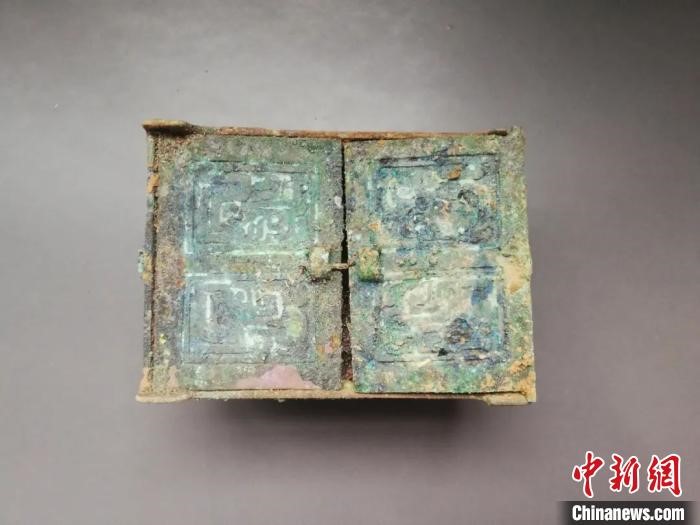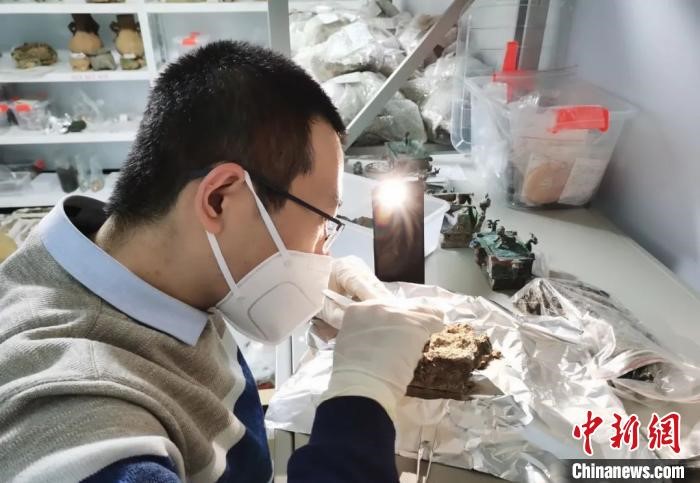

Residues of skin-whitening cosmetic products have recently been found inside a 2,700-year-old bronze box excavated from an ancient cemetery in Yuanqu county, north China's Shanxi province.

Photo shows a bronze cosmetic box excavated from an ancient cemetery located in Yuanqu, north China's Shanxi province. (Photo/Courtesy of Shanxi Provincial Institute of Archaeology)
The bronze cosmetic box was unearthed during a salvage excavation conducted by cultural heritage protection institutions, including the Shanxi Provincial Institute of Archaeology, from April to December 2020.
During the process, a total of nine high-level ancient tombs dating back to the Zhou Dynasty (1046-256 BC) and over 500 artifacts were discovered. Among them, multiple bronze boxes particularly caught archaeologists' attention.

Photo shows a bronze cosmetic box unearthed in Yuanqu county, Shanxi. (Photo/Courtesy of Shanxi Provincial Institute of Archaeology)
Archaeologists confirmed that these miniature boxes were used to contain cosmetics of female aristocrats in the early Spring and Autumn period (771-476 BC) more than 2,700 years ago, following the discovery of residues of mixed red substances within one box.
The red concoction was made from animal fat, vegetable essential oil and cinnabar, according to scientific analysis results released on March 10. Meanwhile, calcite and aragonite, the raw materials of skin-whitening cosmetics, were also found in the residues of another bronze box.

Photo shows an archaeologist conducting scientific analysis of unearthed relics. (Photo/Courtesy of Shanxi Provincial Institute of Archaeology)
These cosmetic products provide pivotal physical evidence for the development of the handicraft industry and the application of cosmetics during the pre-Qin period (pre-221 B.C.), said Yang Jiyun, associate researcher with the Shanxi Provincial Institute of Archaeology.
 Fire brigade in Shanghai holds group wedding
Fire brigade in Shanghai holds group wedding Tourists enjoy ice sculptures in Datan Town, north China
Tourists enjoy ice sculptures in Datan Town, north China Sunset scenery of Dayan Pagoda in Xi'an
Sunset scenery of Dayan Pagoda in Xi'an Tourists have fun at scenic spot in Nanlong Town, NW China
Tourists have fun at scenic spot in Nanlong Town, NW China Harbin attracts tourists by making best use of ice in winter
Harbin attracts tourists by making best use of ice in winter In pics: FIS Alpine Ski Women's World Cup Slalom
In pics: FIS Alpine Ski Women's World Cup Slalom Black-necked cranes rest at reservoir in Lhunzhub County, Lhasa
Black-necked cranes rest at reservoir in Lhunzhub County, Lhasa China's FAST telescope will be available to foreign scientists in April
China's FAST telescope will be available to foreign scientists in April "She power" plays indispensable role in poverty alleviation
"She power" plays indispensable role in poverty alleviation Top 10 world news events of People's Daily in 2020
Top 10 world news events of People's Daily in 2020 Top 10 China news events of People's Daily in 2020
Top 10 China news events of People's Daily in 2020 Top 10 media buzzwords of 2020
Top 10 media buzzwords of 2020 Year-ender:10 major tourism stories of 2020
Year-ender:10 major tourism stories of 2020 No interference in Venezuelan issues
No interference in Venezuelan issues
 Biz prepares for trade spat
Biz prepares for trade spat
 Broadcasting Continent
Broadcasting Continent Australia wins Chinese CEOs as US loses
Australia wins Chinese CEOs as US loses